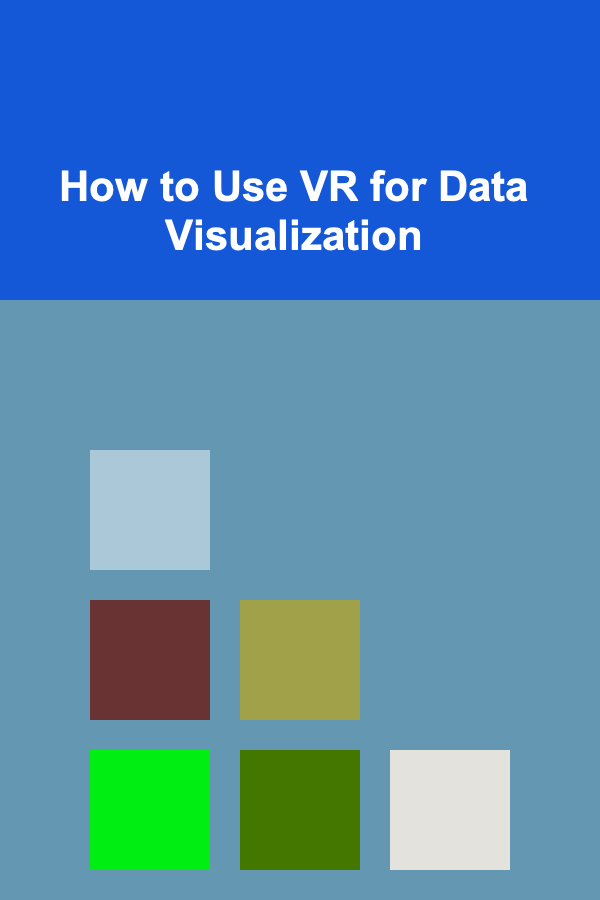
How to Use VR for Data Visualization
ebook include PDF & Audio bundle (Micro Guide)
$12.99$10.99
Limited Time Offer! Order within the next:

Virtual Reality (VR) is transforming the way we interact with data. It offers an immersive experience that enables users to visualize and interact with complex datasets in innovative and intuitive ways. By combining the power of three-dimensional space with the analytical capabilities of data visualization, VR provides a powerful tool for understanding and interpreting data that would otherwise be difficult to grasp through traditional methods like charts or spreadsheets. This article explores the ways in which VR can be used for data visualization, the benefits of this approach, and practical steps for integrating VR into data visualization workflows.
The Power of Virtual Reality in Data Visualization
Data visualization has long been an essential technique for understanding complex datasets. The goal of data visualization is to transform raw data into visual representations, such as graphs, charts, and maps, that allow users to quickly understand patterns, relationships, and trends. However, traditional two-dimensional visualizations can sometimes fail to fully capture the complexity of certain datasets, especially when they involve large-scale or multi-dimensional data.
Virtual Reality offers a solution to these limitations by creating an immersive, three-dimensional environment where users can interact with data in new ways. By using VR, data scientists, analysts, and business professionals can visualize data as three-dimensional objects or interactive scenes, which can provide a more intuitive understanding of the data's underlying patterns.
Benefits of Using VR for Data Visualization
1. Immersion and Intuition
One of the primary benefits of VR is its ability to immerse users in a 3D environment. This immersive experience helps to engage users in a more interactive way than traditional 2D methods. In a VR environment, users can "walk around" data, manipulate it, and observe relationships from different angles. This type of engagement can lead to a deeper understanding of the data, especially for complex datasets that might be hard to interpret in 2D visualizations.
2. Spatial Understanding of Complex Data
For large datasets or multidimensional data, it can be difficult to represent the full complexity in a two-dimensional space. VR allows users to explore datasets in three dimensions, giving them the ability to move through the data and view it from various perspectives. This spatial understanding is especially valuable for tasks like exploring geographical data, scientific simulations, or visualizing high-dimensional data in a way that is difficult to represent on a flat screen.
3. Enhanced Interaction
In traditional data visualizations, users are typically passive observers. They might interact with the data through simple mouse clicks or keyboard inputs, but this interaction is limited. VR, on the other hand, enables dynamic, hands-on interaction. Users can manipulate data objects, zoom in and out, and explore complex relationships by physically moving within the data. This enhanced interaction can be particularly useful for tasks like identifying correlations, exploring trends, or conducting simulations.
4. Real-Time Collaboration
Another powerful aspect of VR is its potential for real-time collaboration. With VR, multiple users can enter the same virtual environment, where they can view and interact with the same data simultaneously. This collaborative aspect can be incredibly useful for team-based data analysis, as it allows team members to discuss and explore the data together in an interactive and immersive setting.
Applications of VR in Data Visualization
There are a wide variety of fields where VR can be used to enhance data visualization. Some of the most prominent applications include:
1. Scientific Research and Simulations
In scientific research, particularly in fields like physics, chemistry, and biology, VR is used to visualize complex data that is difficult to interpret in traditional formats. For instance, researchers studying molecular structures or atomic interactions can use VR to visualize these structures in three dimensions, allowing them to better understand how molecules behave and interact.
Similarly, VR is used in fields like climate science and astronomy to visualize large datasets, such as weather patterns or cosmic phenomena. These datasets often involve complex, multidimensional data that is difficult to analyze without the immersive capabilities of VR.
2. Geographic Information Systems (GIS)
In the field of geographic information systems (GIS), VR has become a powerful tool for visualizing geographical data. GIS professionals can use VR to explore 3D models of terrain, urban environments, or even the interior of buildings. This enables them to better understand geographic patterns, simulate changes to the environment, and make more informed decisions based on spatial data.
For example, urban planners can use VR to create 3D visualizations of cities, enabling them to explore how new buildings, roads, or parks will impact the overall environment. Similarly, environmental scientists can use VR to simulate the effects of climate change on ecosystems, such as rising sea levels or deforestation.
3. Business and Marketing Analytics
In business, VR can be used to visualize and analyze customer behavior, market trends, and other important business metrics. Companies can create VR environments that allow managers and analysts to explore data from different angles, such as visualizing sales data in a 3D space or tracking customer interactions in a virtual store.
VR also plays a significant role in marketing analytics, where brands can use it to create immersive, interactive marketing campaigns. For example, a retailer could create a VR experience where customers can "walk through" a virtual store, interact with products, and make purchases, all while tracking customer behavior to improve their sales strategies.
4. Financial Data and Investment Analysis
The financial industry is another area where VR is increasingly being used for data visualization. Financial analysts can use VR to visualize complex stock market data, financial models, and investment strategies in a more intuitive manner. VR enables users to manipulate data points, visualize trends over time, and simulate potential future outcomes.
Additionally, investors and portfolio managers can use VR to simulate and analyze the performance of different investment portfolios, allowing them to explore potential risks and rewards in a more dynamic way.
Tools and Technologies for VR Data Visualization
To effectively use VR for data visualization, it is essential to use the right tools and technologies. Here are some of the key technologies and platforms that enable VR data visualization:
1. VR Hardware
The first requirement for VR data visualization is the VR hardware itself. This typically includes VR headsets, such as the Oculus Rift, HTC Vive, or the Valve Index, which provide users with an immersive visual experience. VR headsets are often paired with motion controllers that allow users to interact with the virtual environment by pointing, grabbing, or manipulating virtual objects.
In addition to headsets and controllers, some VR systems also require specialized hardware, such as motion capture systems or sensors, to track user movements in real time. This hardware allows users to move around and interact with the data in the VR environment.
2. Software Platforms
To create VR data visualizations, users need specialized software that can generate and render three-dimensional data environments. Some of the most widely used platforms for VR data visualization include:
- Unity3D: Unity is a powerful game engine that is frequently used to create VR applications. It supports a wide range of VR headsets and offers a robust set of tools for creating 3D models and environments. Unity can be used to build custom data visualization applications that are immersive and interactive.
- Unreal Engine: Similar to Unity, Unreal Engine is another popular game engine that supports VR development. It is known for its high-quality rendering capabilities, making it ideal for creating realistic and visually stunning VR experiences. Unreal Engine is often used in applications where visual fidelity is crucial, such as architectural visualization or scientific simulations.
- Microsoft Power BI with VR Support: Microsoft's Power BI, a business analytics tool, supports VR through integration with the Microsoft HoloLens. This enables users to view and interact with business data in a mixed reality environment.
- Blender: Blender is a 3D modeling tool that is often used for creating models and visualizations that can be used in VR environments. It is open-source and supports VR development through various plugins and add-ons.
3. Data Integration Tools
Data integration is a crucial part of VR data visualization. In many cases, the raw data needs to be processed and formatted before it can be rendered in a VR environment. Some popular tools and frameworks for integrating data into VR environments include:
- D3.js: D3.js is a JavaScript library used for manipulating and visualizing data in web-based environments. Although D3.js is primarily used for creating 2D data visualizations, it can also be used in combination with VR tools to create interactive 3D data visualizations.
- WebVR and WebXR: WebVR and WebXR are APIs that allow developers to create VR experiences that run directly in web browsers. These tools make it easier to integrate data into VR applications that can be accessed via a variety of devices, including desktop computers, mobile devices, and VR headsets.
Challenges of Using VR for Data Visualization
While VR offers many benefits for data visualization, there are also challenges that need to be addressed. Some of the key challenges include:
1. Data Complexity
Not all types of data are suited for visualization in a VR environment. While VR is ideal for certain types of spatial or multi-dimensional data, it may not be the best option for all datasets. For instance, simple 2D data visualizations, such as bar charts or line graphs, may not benefit much from VR immersion.
2. Cost and Accessibility
VR hardware and software can be expensive, and not all organizations have access to the necessary tools and resources to implement VR data visualization. Additionally, the complexity of VR development may require specialized skills, which can be a barrier to entry for many data scientists or analysts.
3. User Comfort and Adoption
Some users may experience discomfort when using VR headsets, such as nausea or eye strain. These issues, often referred to as "VR sickness," can make it difficult for users to engage with VR applications for extended periods. To overcome these challenges, VR applications need to be optimized for user comfort, and developers need to ensure that the experiences are smooth and intuitive.
4. Scalability and Performance
As VR environments become more complex, performance can become an issue. Rendering high-quality 3D visualizations in real time can be computationally demanding, particularly when dealing with large datasets. To address these concerns, developers need to optimize VR applications for performance to ensure smooth and responsive experiences.
Conclusion
Virtual Reality is revolutionizing the way we visualize and interact with data. By providing an immersive and interactive environment, VR enables users to explore complex datasets in ways that were previously not possible with traditional 2D methods. From scientific research to business analytics, VR data visualization has a wide range of applications and can help users gain deeper insights into their data.
However, despite its many advantages, VR for data visualization is still a developing field, and there are challenges to overcome, such as data complexity, cost, and user comfort. Nevertheless, with the continued advancement of VR technologies and data integration tools, VR is poised to become a crucial tool for data analysis and decision-making in the future. By combining the power of three-dimensional space with the analytical capabilities of data visualization, VR is setting the stage for a new era of data exploration.
Reading More From Our Other Websites
- [Home Lighting 101] How to Incorporate LED Lighting into Your Home Decor
- [Screen Printing Tip 101] Best Screen Printing Setup for Printing on Knit Fabrics -- Tips & Tricks
- [Home Space Saving 101] How to Master Small Appliance Storage: Clever Solutions for Clutter-Free Countertops and Cupboards
- [Small Business 101] Best Ways to Protect Your Small Business Intellectual Property When Working with Freelancers
- [Home Security 101] How to Set Up a Home Security System for Your Airbnb Property
- [Home Party Planning 101] How to Make Your Party Stand Out with Unique Party Favors
- [Home Family Activity 101] How to Play Family Storytelling Games for Creative Fun
- [Home Family Activity 101] How to Host an Epic Family Bubble Making Extravaganza in Your Own Backyard
- [Home Budget 101] How to Save Money on Your Mortgage and Pay Down Debt Faster
- [Home Security 101] How to Reinforce Your Sliding Glass Doors for Maximum Security

How to Make the Most of a Small Workspace
Read More
How to Organize Vintage Perfume Bottles Collectively
Read More
How to Set Up a Shared Digital Calendar with Your Team
Read More
How to Start a Home Budget with a Small Income
Read More
Mastering Dental Hygiene: A Comprehensive Guide for Dental Hygienists
Read More
Understanding the Psychology of Groups
Read MoreOther Products

How to Make the Most of a Small Workspace
Read More
How to Organize Vintage Perfume Bottles Collectively
Read More
How to Set Up a Shared Digital Calendar with Your Team
Read More
How to Start a Home Budget with a Small Income
Read More
Mastering Dental Hygiene: A Comprehensive Guide for Dental Hygienists
Read More